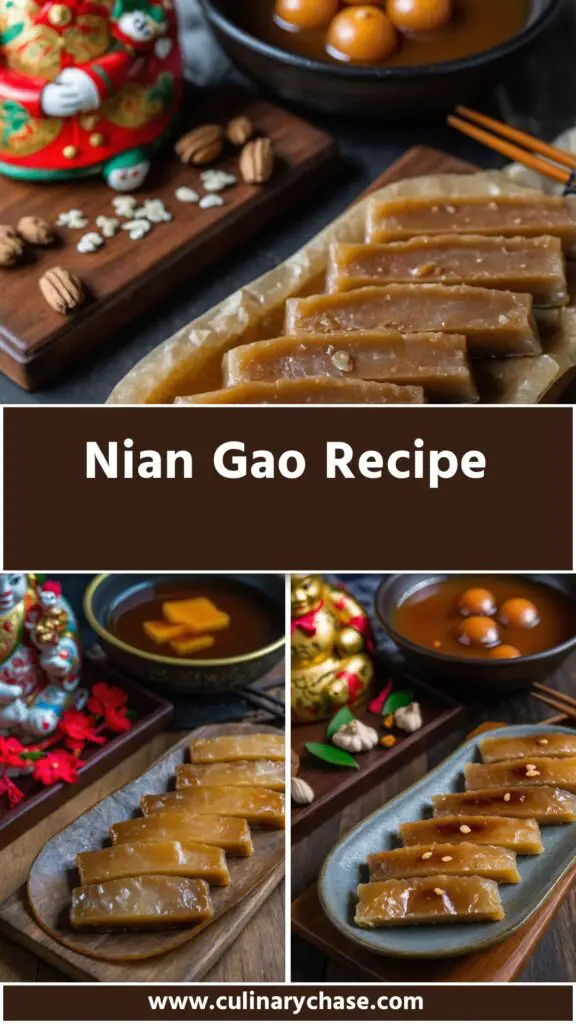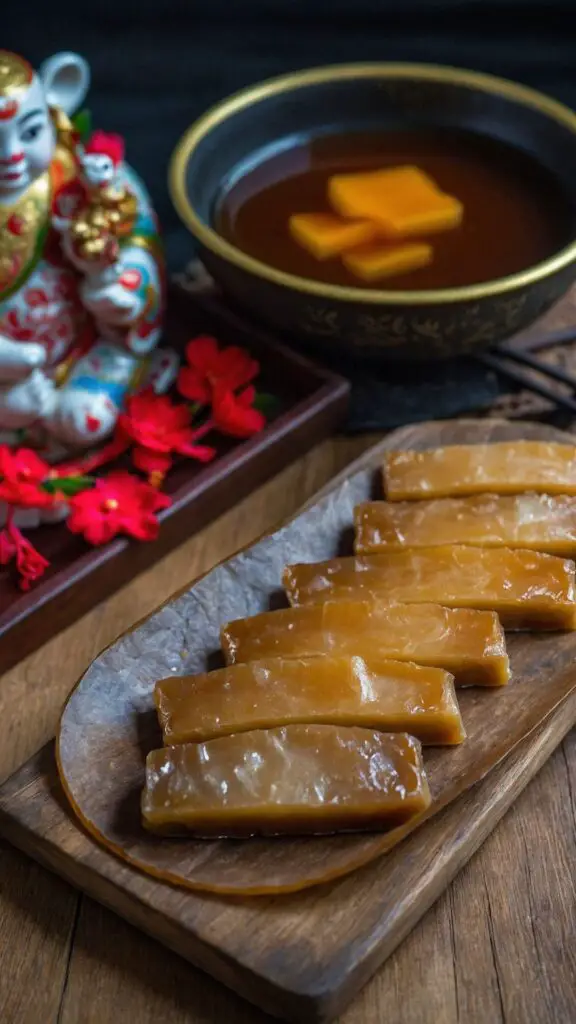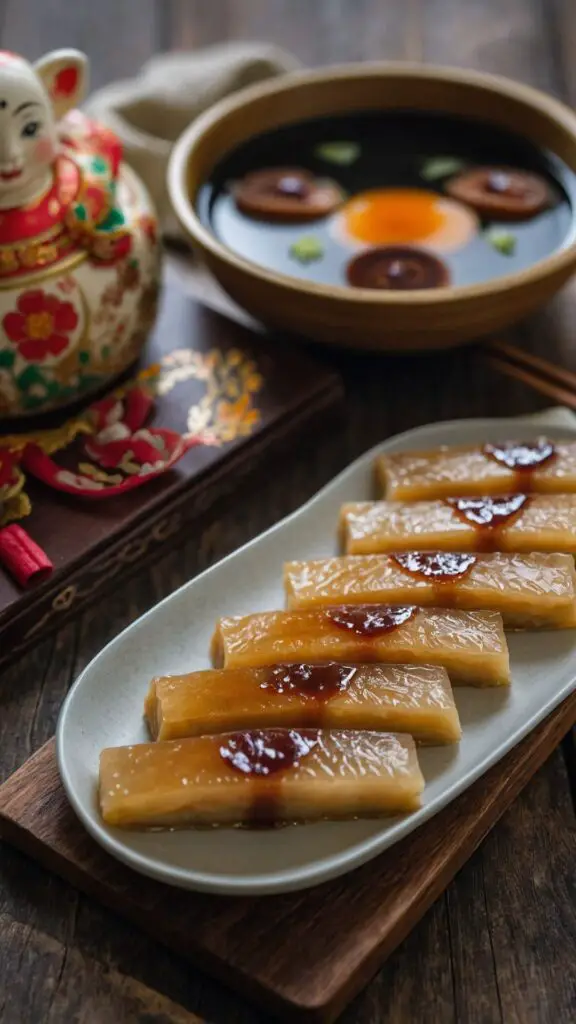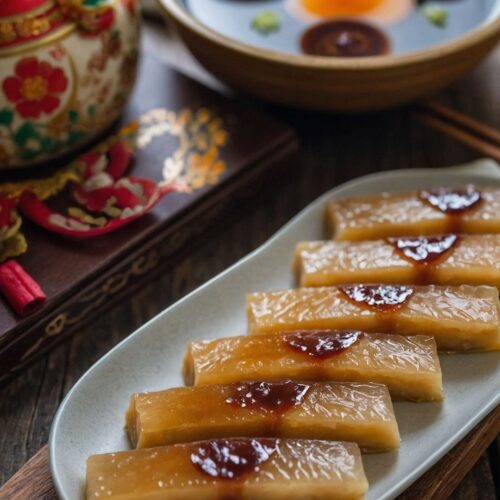Nian Gao Recipe – Culinary Chase
Before diving into the delightful details of making nian gao, let’s take a moment to think about what pairs beautifully with this dish. Nian gao, with its chewy texture and subtle sweetness, goes well with savory dishes.
Think about a stir-fried vegetable medley with garlic if you want something simple. A spicy Sichuan-style chicken would also offer a great contrast to the dish’s sweetness. If you want to keep it light, a refreshing cucumber salad can act as a palate cleanser. Whatever you choose, the balance of flavors will make your meal unforgettable.

Food has a way of connecting us to our roots, and for many, nian gao represents a link to cultural traditions and familial gatherings. The moment I first tasted nian gao, I felt enveloped in a warm hug of flavors, textures, and memories.
This unique Chinese delicacy, often enjoyed during the Lunar New Year, is more than just a dish—it’s a symbol of prosperity and good fortune. Join me as we explore the rich world of nian gao, uncovering its flavors, variations, and the joys of making it at home.
What is Nian Gao?
Nian gao, pronounced “nyen gao,” translates to “year cake” in English. It’s a traditional Chinese dessert made primarily from glutinous rice flour and water.
This dish is steamed until it becomes a firm, chewy cake. Its creation often involves the blending of textures and flavors, transforming basic ingredients into something incredibly satisfying. Various regional versions exist, some featuring different flavors or fillings. However, the version I cherish is the classic sweet one, adorned with just a hint of orange zest and a touch of molasses.
You will also like the following Dessert recipes!
- Dark Chocolate Covered Almonds
- Copycat Qdoba Chocolate Chip Cookie
- Quick and Easy Hong Kong Egg Tarts
What is the Flavor Profile of This Dish?
Nian gao boasts a unique flavor profile that balances sweetness and subtle spice. The sweetness comes primarily from brown sugar and a hint of vanilla, which meld perfectly with the chewy texture.
The addition of orange zest gives a refreshing brightness, while the allspice powder adds a warm, slightly peppery note. The blend of these ingredients results in a comforting treat that feels nostalgic for many and delightful for all.
What Makes This Recipe Different From Other Nian Gao Recipes?
This particular nian gao recipe sets itself apart by incorporating rich flavors and thoughtful details. While traditional recipes often stick to the basics, this version offers a subtle depth with dark molasses and allspice.
The orange zest adds an unexpected twist that elevates the dish beyond mere sweetness, creating a rich tapestry of flavor. Plus, using a combination of glutinous rice flour and regular rice flour helps achieve that perfect chewy texture while maintaining a bit more complexity overall.
Ingredients You’ll Need
Here’s a quick look at what you’ll need to create your very own nian gao:
- 1½ pounds glutinous rice flour (This is key for that chewy texture.)
- ½ pound rice flour (A little addition for a unique touch.)
- 3½ to 4 cups of water (Depending on your humidity levels; more moisture might be needed in dry areas.)
- 2 cups dark brown sugar (Feel free to use brown rock sugar here.)
- 2 teaspoons vegetable oil (Plus more for brushing your baking pans.)
- 1 tablespoon vanilla extract (For a boost of flavor.)
- 1 tablespoon dark molasses (This adds richness.)
- ½ teaspoon allspice powder (Just a hint makes a difference.)
- Zest of 1 large orange (Brightness in every bite.)
- 4 slices ginger (Optional, but adds a lovely depth.)
- 6 dried dates (For decoration, totally optional.)

Step-by-Step Directions
Step 1: Prepare Your Ingredients
Gather all of your ingredients on your kitchen counter. Having everything in one place streamlines the process. Measure out your flours, sugar, and any other items you need. This is your kitchen; embrace it.
Step 2: Mix the Dry Ingredients
In a large mixing bowl, combine the glutinous rice flour, rice flour, allspice powder, and orange zest. Use a whisk to make sure there are no lumps—a smooth mix leads to a smooth cake.
Step 3: Stir in the Liquid Ingredients
Slowly add the water, vanilla extract, dark molasses, and vegetable oil to the dry mix. Stir until it’s well combined; you should have a thick, smooth batter. If it feels too thick, add a splash more water, but aim for a pudding-like consistency.
Step 4: Prepare the Steamer
While you’re mixing, it’s time to get your steamer ready. Fill it with water and bring it to a gentle boil. Grease your baking dish with vegetable oil to ensure the nian gao won’t stick. You can use a round cake pan or a square baking dish—whatever you have on hand!
Step 5: Pour the Batter
Once your batter is ready, pour it into the greased baking dish. Spread it out evenly with a spatula to ensure even cooking. Gently press the ginger slices on top, if using.
Step 6: Steam the Nian Gao
Cover the baking dish with a piece of parchment paper or a clean kitchen cloth to trap the steam. Place it in the steamer and let it steam for about 45-60 minutes. The nian gao should firm up and be set when you check it with a toothpick.
Step 7: Cool and Slice
When the timer goes off, carefully remove the nian gao from the steamer. Let it cool completely, then run a knife around the edges to help with removal. Flip the dish upside down on a cutting board, and gently tap it until the nian gao releases.
Step 8: Enjoy!
Slice the nian gao into squares or rectangles and enjoy either warm or at room temperature. It can be eaten plain, or you can sauté it in a bit of oil until crispy for texture, making it an exciting dish to serve to family or friends.
Tips on Making Nian Gao
- Humidity Matters: Adjust your water component based on the weather. More moisture may be necessary in drier climates for the right texture.
- Grease Wisely: Don’t skimp on oil when prepping your baking pan; a well-greased dish means flawless removal of the cake.
- Flavor Experimentation: Feel free to experiment with flavors. Try adding coconut milk or nuts as toppings or within the cake itself.
- Steaming Time is Key: Keep an eye on your cake towards the end of the steaming time. Overcooking may lead to a dry texture.
- Serving Suggestions: Don’t hesitate to mix nian gao with savory dishes for variety. It pairs well with stir-fried vegetables and proteins, which adds to its versatility.
Nutrition Information
A serving of nian gao (about 100 grams) typically contains approximately:
- Calories: 250
- Carbohydrates: 58g
- Protein: 2g
- Fat: 1g
- Fiber: 1g
- Sugar: 14g
How Can I Store This Nian Gao Recipe?
Nian gao can be stored in an airtight container in the refrigerator for up to a week. If you prefer, slice it first to make it easier to grab portions as you go. If you want to preserve it longer, freeze it in portions. When you’re ready to enjoy, steam it directly from frozen for a seamless treat.

Substitutes for Ingredients
If you’re missing some of the ingredients, here are some alternatives that work well:
- Glutinous Rice Flour: Use sweet rice flour if glutinous rice flour is unavailable. It serves a similar purpose, ensuring that chewy texture.
- Dark Brown Sugar: Substitute with coconut sugar for a different sweetness—just keep the texture in mind.
- Vegetable Oil: Coconut oil or canola oil can serve as effective substitutes, providing a mild flavor.
- Allspice Powder: If you’re out of allspice, try a combination of cinnamon and nutmeg to mimic that warm, spiced essence.

Nian Gao Recipe
Equipment
- Bowl
- Spatula
Ingredients
- 1½ pounds glutinous rice flour This is key for that chewy texture.
- ½ pound rice flour A little addition for a unique touch.
- 3½ to 4 cups of water Depending on your humidity levels; more moisture might be needed in dry areas.
- 2 cups dark brown sugar Feel free to use brown rock sugar here.
- 2 teaspoons vegetable oil Plus more for brushing your baking pans.
- 1 tablespoon vanilla extract For a boost of flavor.
- 1 tablespoon dark molasses This adds richness.
- ½ teaspoon allspice powder Just a hint makes a difference.
- Zest of 1 large orange Brightness in every bite.
- 4 slices ginger Optional, but adds a lovely depth.
- 6 dried dates For decoration, totally optional.
Instructions
Step 1: Prepare Your Ingredients
- Gather all of your ingredients on your kitchen counter. Having everything in one place streamlines the process. Measure out your flours, sugar, and any other items you need. This is your kitchen; embrace it.
Step 2: Mix the Dry Ingredients
- In a large mixing bowl, combine the glutinous rice flour, rice flour, allspice powder, and orange zest. Use a whisk to make sure there are no lumps—a smooth mix leads to a smooth cake.
Step 3: Stir in the Liquid Ingredients
- Slowly add the water, vanilla extract, dark molasses, and vegetable oil to the dry mix. Stir until it’s well combined; you should have a thick, smooth batter. If it feels too thick, add a splash more water, but aim for a pudding-like consistency.
Step 4: Prepare the Steamer
- While you’re mixing, it’s time to get your steamer ready. Fill it with water and bring it to a gentle boil. Grease your baking dish with vegetable oil to ensure the nian gao won’t stick. You can use a round cake pan or a square baking dish—whatever you have on hand!
Step 5: Pour the Batter
- Once your batter is ready, pour it into the greased baking dish. Spread it out evenly with a spatula to ensure even cooking. Gently press the ginger slices on top, if using.
Step 6: Steam the Nian Gao
- Cover the baking dish with a piece of parchment paper or a clean kitchen cloth to trap the steam. Place it in the steamer and let it steam for about 45-60 minutes. The nian gao should firm up and be set when you check it with a toothpick.
Step 7: Cool and Slice
- When the timer goes off, carefully remove the nian gao from the steamer. Let it cool completely, then run a knife around the edges to help with removal. Flip the dish upside down on a cutting board, and gently tap it until the nian gao releases.
Step 8: Enjoy!
- Slice the nian gao into squares or rectangles and enjoy either warm or at room temperature. It can be eaten plain, or you can sauté it in a bit of oil until crispy for texture, making it an exciting dish to serve to family or friends.
Notes
- Humidity Matters: Adjust your water component based on the weather. More moisture may be necessary in drier climates for the right texture.
- Grease Wisely: Don’t skimp on oil when prepping your baking pan; a well-greased dish means flawless removal of the cake.
- Flavor Experimentation: Feel free to experiment with flavors. Try adding coconut milk or nuts as toppings or within the cake itself.
- Steaming Time is Key: Keep an eye on your cake towards the end of the steaming time. Overcooking may lead to a dry texture.
- Serving Suggestions: Don’t hesitate to mix nian gao with savory dishes for variety. It pairs well with stir-fried vegetables and proteins, which adds to its versatility.
Nutrition
Frequently Asked Questions
1. Can I make nian gao gluten-free?
While traditional nian gao uses glutinous rice flour, some brands offer gluten-free versions. Check for “gluten-free rice flour” or alternatives that maintain the desired texture.
2. How do I know when the nian gao is done steaming?
Insert a toothpick in the center. If it comes out clean, your nian gao is ready. If any gooey batter sticks to it, continue steaming.
3. Any tips for reheating leftover nian gao?
You can steam leftover slices or lightly pan-fry them in a bit of oil. Both methods keep the dish moist and flavorful.
4. What occasions is nian gao typically served?
Traditionally, nian gao is served during Lunar New Year celebrations to symbolize prosperity and good luck. However, it’s delightful year-round!
5. How do I achieve the perfect chewy texture?
The key is using the right ratio of glutinous rice flour to water. Make sure to measure accurately and maintain humidity for optimal results.
Conclusion
Crafting nian gao at home allows you to indulge in its unique flavors and textures, filling your kitchen with enticing aromas. This dish embodies tradition and modern flair, offering endless possibilities in how you serve it.
Whether paired with savory sides or enjoyed by itself, nian gao is a wonderful addition to your culinary repertoire. So gather your ingredients, embrace the process, and savor every bite! The delightful chewy texture and engaging flavors will undoubtedly make this dish a favorite in your household.
